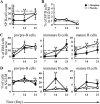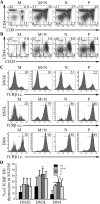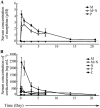Depletion and recovery of lymphoid subsets following morphine administration
- PMID: 21557737
- PMCID: PMC3246708
- DOI: 10.1111/j.1476-5381.2011.01475.x
Depletion and recovery of lymphoid subsets following morphine administration
Abstract
Background and purpose: Opioid use and abuse has been linked to significant immunosuppression, which has been attributed, in part, to drug-induced depletion of lymphocytes. We sought to define the mechanisms by which lymphocyte populations are depleted and recover following morphine treatment in mice.
Experimental approach: Mice were implanted with morphine pellets and B- and T-cell subsets in the bone marrow, thymus, spleen and lymph nodes were analysed at various time points. We also examined the effects of morphine on T-cell development using an ex vivo assay.
Key results: The lymphocyte populations most susceptible to morphine-induced depletion were the precursor cells undergoing selection. As the lymphocytes recovered, more lymphocyte precursors proliferated than in control mice. In addition, peripheral T-cells displayed evidence that they had undergone homeostatic proliferation during the recovery phase of the experiments.
Conclusions and implications: The recovery of lymphocytes following morphine-induced depletion occurred in the presence of morphine and via increased proliferation of lymphoid precursors and homeostatic proliferation of T-cells.
© 2011 The Authors. British Journal of Pharmacology © 2011 The British Pharmacological Society.
Figures









Comment in
-
Opioids and the immune system: what is their mechanism of action?Br J Pharmacol. 2011 Dec;164(7):1826-8. doi: 10.1111/j.1476-5381.2011.01513.x. Br J Pharmacol. 2011. PMID: 21627636 Free PMC article.
Similar articles
-
Equianalgesic doses of subcutaneous but not intrathecal morphine alter phenotypic expression of cell surface markers and mitogen-induced proliferation in rat lymphocytes.Anesthesiology. 1996 Aug;85(2):355-65. doi: 10.1097/00000542-199608000-00018. Anesthesiology. 1996. PMID: 8712452
-
Effect of cyclosporine on different porcine lymphoid tissues.Transplant Proc. 1994 Oct;26(5):2865. Transplant Proc. 1994. PMID: 7940903 No abstract available.
-
Endogenous opioid inhibition of proliferation of T and B cell subpopulations in response to immunization for experimental autoimmune encephalomyelitis.BMC Immunol. 2015 Apr 24;16:24. doi: 10.1186/s12865-015-0093-0. BMC Immunol. 2015. PMID: 25906771 Free PMC article.
-
Influence of polysaccharide fractions isolated from Caltha palustris L. on the cellular immune response in collagen-induced arthritis (CIA) in mice. A comparison with methotrexate.J Ethnopharmacol. 2013 Jan 9;145(1):109-17. doi: 10.1016/j.jep.2012.10.038. Epub 2012 Nov 1. J Ethnopharmacol. 2013. PMID: 23123796
-
[Suppressor lymphocytes of the B series--B suppressors].Usp Sovrem Biol. 1981 Jan-Feb;91(1):8-28. Usp Sovrem Biol. 1981. PMID: 6455876 Review. Russian. No abstract available.
Cited by
-
Effect of Opioid Use on Immune Activation and HIV Persistence on ART.J Neuroimmune Pharmacol. 2020 Dec;15(4):643-657. doi: 10.1007/s11481-020-09959-y. Epub 2020 Sep 25. J Neuroimmune Pharmacol. 2020. PMID: 32974750 Free PMC article. Review.
-
Prolonged Morphine Exposure Induces Increased Firm Adhesion in an in Vitro Model of the Blood-Brain Barrier.Int J Mol Sci. 2016 Jun 9;17(6):916. doi: 10.3390/ijms17060916. Int J Mol Sci. 2016. PMID: 27294916 Free PMC article.
-
Endogenous thymic regeneration: restoring T cell production following injury.Nat Rev Immunol. 2025 Jun;25(6):407-424. doi: 10.1038/s41577-024-01119-0. Epub 2025 Jan 6. Nat Rev Immunol. 2025. PMID: 39762553 Review.
-
Opioids and the immune system: what is their mechanism of action?Br J Pharmacol. 2011 Dec;164(7):1826-8. doi: 10.1111/j.1476-5381.2011.01513.x. Br J Pharmacol. 2011. PMID: 21627636 Free PMC article.
-
Adenosine deaminase activity modulation by some street drug: molecular docking simulation and experimental investigation.Daru. 2014 May 2;22(1):42. doi: 10.1186/2008-2231-22-42. Daru. 2014. PMID: 24887139 Free PMC article.
References
-
- Aderjan R, Hofmann S, Schmitt G, Skopp G. Morphine and morphine glucuronides in serum of heroin consumers and in heroin-related deaths determined by HPLC with native fluorescence detection. J Anal Toxicol. 1995;19:163–168. - PubMed
-
- Arora PK, Fride E, Petitto J, Waggie K, Skolnick P. Morphine-induced immune alterations in vivo. Cell Immunol. 1990;126:343–353. - PubMed
-
- Askenasy EM, Askenasy N, Askenasy JJ. Does lymphopenia preclude restoration of immune homeostasis? The particular case of type 1 diabetes. Autoimmun Rev. 2010;9:687–690. - PubMed
-
- Ayala A, Herdon CD, Lehman DL, DeMaso CM, Ayala CA, Chaudry IH. The induction of accelerated thymic programmed cell death during polymicrobial sepsis: control by corticosteroids but not tumor necrosis factor. Shock. 1995;3:259–267. - PubMed
-
- Bach JF, Duval D, Dardenne M, Salomon JC, Tursz T, Fournier C. The effects of steroids on T-cells. Transplant Proc. 1975;7:25–30. - PubMed
Publication types
MeSH terms
Substances
Grants and funding
LinkOut - more resources
Full Text Sources
Research Materials

